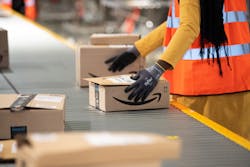Amazon Reveals Nearly 20,000 Workers Could Have Had COVID-19
Amazon has reported on its blog that 19,816 employees have tested or been presumed positive for COVID-19.
The company analyzed data on its 1,372,000 Amazon and Whole Foods Market frontline employees who were employed in the United States at any time between March 1 and Sept. 19, 2020. Amazon found 1.4% of workers were confirmed or presumed to have COVID-19. (This analysis does not include the network of third-party delivery drivers who, in addition to UPS and USPS, deliver packages to customers.)
“As part of this commitment, we've decided to publicly share the COVID-19 infection rates among Amazon front-line employees—something few if any companies and no other major retailers have done,” Amazon wrote on its blog post. "We hope sharing this data and our learnings will encourage others to follow and will prove useful as states make decisions about reopening public facilities and employers consider whether and how to bring people back to work.”
A state-by-state percentage breakdown of COVID-19 cases found that 3.17% of Amazon workers in Minnesota were presumed to have had COVID-19, the highest in the nation and double the rate of infection in the general population. The data didn’t specify the actual numbers of cases or where those employees work.
Amazon, one of the U.S.’s largest employers, has been one of the biggest corporate winners during the pandemic as people have stocked up on supplies and switched to online shopping. The company reported Q2 2020 earnings of $88.9 billion in revenue, up 40% year over year, and $5.2 billion in quarterly profit, the largest in the company’s 26-year history.
Amazon CFO Brian Olsavsky told analysts during the Q2 earnings call that the company spent more than $4 billion on coronavirus-related expenses in Q2 and the company expects to spend another $2 billion in Q3.
The company has introduced or changed more than 150 safety measures since the pandemic began, including mandatory temperature checks, enhanced cleaning procedures and social distancing measures. Amazon has eliminated stand-up meetings during shifts, staggered break times and spread out chairs in breakrooms. In a Sept. 22 blog, the company shared additional details of how it is responding to the novel coronavirus.
Amazon is building out its testing capacity and has assembled an internal team and hired dozens of lab technicians, according to its Oct. 1 blog. Thousands of tests are already being performed daily and are expected to grow to 50,000 tests a day across 650 sites by November. The company’s goal is to test the bulk of its frontline workers every two weeks, with employees testing themselves with nasal swabs, CNBC reported.
The online retailer has been criticized by labor groups, politicians, regulators and employees for not doing enough to keep employees safe and not closing warehouses following reports of positive COVID-19 cases.
CNBC reported that Amazon warehouse workers compiled a crowdsourced database of infections based on notifications of new cases across the U.S. There have been eight confirmed deaths of Amazon warehouse employees due to COVID-19. The last reported death was back in May, as reported by NBC news.
The Los Angeles Times reported that Sunday, a group of current and former Amazon warehouse employees marched outside CEO Jeff Bezos’ mansion in Beverly Hills, Calif., to demand better working conditions.
Amazon has previously been cited for workplace conditions. Read more about Amazon and workplace safety in these articles in our sister publication, EHS Today:
Amazon Responds to Criticism for High Injury Rates
Does Amazon Care About Worker Safety?
Different Amazon Warehouses Spawn Concern from Worker Advocates
OSHA Cites Five Firms After Temporary Worker Dies at Amazon Fulfillment Center
About the Author
Nicole Stempak
Nicole Stempak is managing editor of EHS Today, and a contributing editor to Material Handling & Logistics. She was previously editor of Hemp Grower and Physicians Practice and senior editor of iAdvance Senior Care magazines.
